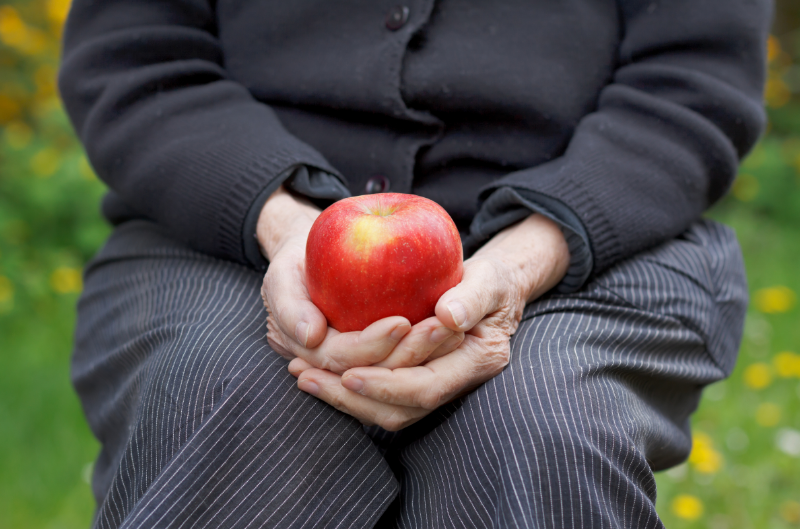As we become older, we need some important changes in our daily eating habits to meet the unique nutrition needs of old age.
Here’s the basic framework we can follow while deciding what to eat and what to avoid in the elderly.
1. Eat a balanced diet using five food groups.
The five food groups include vegetables, fruits, cereals, meat, and milk products. Instead of focusing on only one group, we should take a balanced diet containing items from these five groups. Here’s a brief list of items from these groups and their medical importance in the elderly.
- Vegetables: Dark leafy green vegetables such as spinach, kale, broccoli, mustard green, leek, arugula, bok choy, and all lettuces. These items are usually rich in nutrients such as vitamin-K, which increases bone mineralization reducing the incidence of bone fracture in old age.
- Fruits: Red and orange-colored fruits like oranges, apples, bell peppers, tomatoes, and berries. Moreover, guava, berries, kiwi, and papaya can also have many health benefits in the elderly; for instance, they are rich in vitamin C, which is an antiaging agent.
- Cereals: Wheat germ, oatmeal, brown rice, quinoa, rye, and other whole grains are rich in fiber. Thus, these items can improve digestive tract functioning and reduce the risk for colon cancer (which predominantly occurs in older age).
- Meat and poultry items: Meat products such as fish, chicken, seafood, unprocessed meat, and eggs are rich in protein, vitamin B12, iron, zinc, and selenium. After 50, we face a progressive and generalized loss of skeletal muscle mass and strength; that is why protein products are recommended as an essential part of a balanced diet to slow down muscle loss due to old age.
- Milk and dairy products: Milk and its products like yogurt, custard, and other low-fat dairy products are a good source of calcium. In old age, almost 50% of women and 33% of men are affected by osteoporosis (a disease characterized by bone loss and bone demineralization resulting in the weakening of long bones). These calcium-containing products can slow down the process of bone loss in the elderly.
2. Keep ourselves well-hydrated
According to the National Council on Aging (NCA), we are more prone to dehydration in the older age due to changes in body composition and reduced functioning of thirst centers in the brain. Thus, a close eye on our water intake is necessary to keep ourselves healthy because it is a basic requirement for food digestion, nutrient absorption, and excretion of body wastes.
To keep ourselves well-hydrated, we should drink at least 8 glasses of plain water per day in our old age.
What if we cannot drink plenty of plain simple water? We can add water-rich foods to regular meals, such as watermelons, lettuce, strawberry, cucumbers, soups, or broths.
3. Eat plenty of fiber in old age.
The prevalence of constipation and hypercholesterolemia (increased levels of blood cholesterol) in the elderly is relatively higher than in the youth because of decreased mobility and comorbid medical conditions. That is why dietitians usually recommend a high-fiber diet in the elderly. Following are the two main types of fibers that should be a part of our eating pattern.
- Soluble fibers: Barley, oats, beans, figs, apples, and prunes are good sources of soluble fibers. These fibers can easily dissolve in the water during digestion and help in reducing blood cholesterol levels and glucose levels. Moreover, they also decrease the symptoms of gastritis and heartburn in old age.
- Insoluble fibers: These are usually found in cereals, lentils, whole-wheat bread, avocado, and nuts. Due to their laxative nature, fibers add bulk to the stool, promote gut mobility, and thus, improve food digestion, preventing constipation and other gastrointestinal diseases.
4. Reduce the intake of saturated fat
As we turn 60+, the risk for heart disease and other cardiovascular disorders increases from 40% to 75% due to abnormal lipid profiles in older age. To keep the blood lipid content within limits, it is the right time to reduce the intake of saturated fat-containing items in our diet, such as processed meat, burgers, pizza, potato chips, pastries, and others.
Rather than using saturated fats, we can use unsaturated fats such as nut butter, olive oil, fish oil, spreads, and avocado. Omega 3-fatty acids present in these foods reduce blood pressure, prevent atherosclerosis (deposition of fats in the blood arteries that may lead to heart attack and stroke), and lessen the chances of sudden cardiac death.
5. Limit added sugars and salts.
The elderly are at increased risk for developing type-2-diabetes, hypertension (commonly known as high blood pressure), and heart diseases. Unfortunately, added sugars and salts (essentially sugar and salt that do not naturally occur in foods) contribute significantly to the development of these diseases.
That is why we should limit ourselves from using foods and drinks that contain added sugars like soft and energy drinks, vitamin waters, and bakery items such as pastries, ice creams, frozen desserts, cakes, cookies, and brownies.
Similarly, we should also avoid added salts because it contains sodium, which can cause increased blood pressure in the elderly. Salt must be restricted to only ½to ¾tablespoon per day for elders above 50.
We can use natural milk products, fruits, cereals, and fresh juices in the swap. To meet the cravings for salt, we can use mild spices to make the food tastier and more appealing.
Remember that it is not a rigid document but a basic framework that may guide us on how to accustom our daily eating habits in old age.

